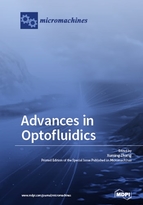Advances in Optofluidics
A special issue of Micromachines (ISSN 2072-666X).
Deadline for manuscript submissions: closed (31 January 2018) | Viewed by 54818
Special Issue Editor
Interests: microfluidics; optofluidics; biomimetics; photocatalysis; plasmonics
Special Issues, Collections and Topics in MDPI journals
Special Issue Information
Dear Colleagues,
Optofluidics a niche research field that integrates optics with microfluidics. It started with elegant demonstrations of the passive interaction of light and liquid media such as liquid waveguides and liquid tunable lenses. Recently, the optofluidics continues the advance in liquid-based optical devices/systems. In addition, it has expanded rapidly into many other fields that involve lightwave (or photon) and liquid media. This Special Issue invites review articles (only review articles) that update the latest progress of the optofluidics in various aspects, such as new functional devices, new integrated systems, new fabrication techniques, new applications, etc. It will cover, but is not limited to, topics such as micro-optics in liquid media, optofluidic sensors, integrated micro-optical systems, displays, optofluidics-on-fibers, optofluidic manipulation, energy and environmental applciations, and so on.
Prof. Dr. Xuming Zhang
Guest Editor
Manuscript Submission Information
Manuscripts should be submitted online at www.mdpi.com by registering and logging in to this website. Once you are registered, click here to go to the submission form. Manuscripts can be submitted until the deadline. All submissions that pass pre-check are peer-reviewed. Accepted papers will be published continuously in the journal (as soon as accepted) and will be listed together on the special issue website. Research articles, review articles as well as short communications are invited. For planned papers, a title and short abstract (about 100 words) can be sent to the Editorial Office for announcement on this website.
Submitted manuscripts should not have been published previously, nor be under consideration for publication elsewhere (except conference proceedings papers). All manuscripts are thoroughly refereed through a single-blind peer-review process. A guide for authors and other relevant information for submission of manuscripts is available on the Instructions for Authors page. Micromachines is an international peer-reviewed open access monthly journal published by MDPI.
Please visit the Instructions for Authors page before submitting a manuscript. The Article Processing Charge (APC) for publication in this open access journal is 2600 CHF (Swiss Francs). Submitted papers should be well formatted and use good English. Authors may use MDPI's English editing service prior to publication or during author revisions.
Keywords
- Optofluidics
- Liquid waveguides
- Optofluidic display
- Optofluidics-on-fibers
- Optofluidic sensors
- Optofluidic manipulation
- Energy and environment







